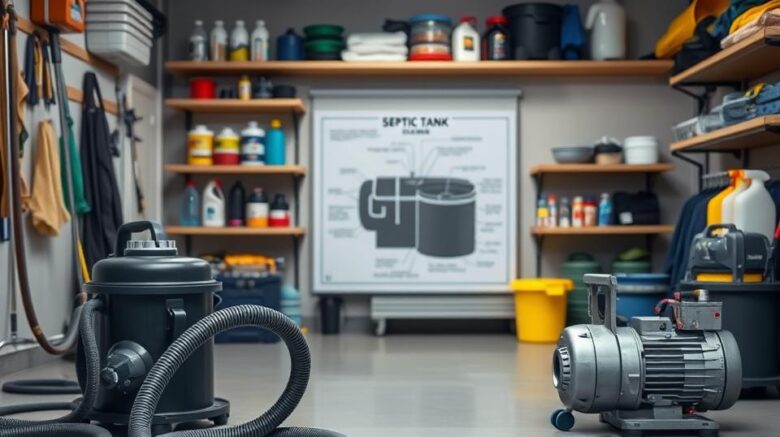Septic Tank Pumping Rates
Have you thought about the real price of maintaining your septic system up to date, or whether you’re spending more than necessary? It’s critical for homeowners to grasp the details of septic tank pumping prices. Typically, the fee is roughly $420, yet it can vary significantly. This spread comes from factors like your system’s capacity and where you live – septic tank pumping services.
Routine servicing of your septic tank prevents expensive fixes, underscoring the importance of understanding service costs. We aim to dive into septic tank service pricing comprehensively. This will allow you to budget cost‑effectively for your system’s care.
Key Highlights
- Average septic tank pumping costs about $420 USD.
- Prices can sit between $290 USD and $560 depending on various variables.
- Regular servicing prevents larger repairs down the line.
- Most households need pumping every 3 to 5 years.
- Household size and water usage can influence pumping interval.
Understanding the Value of Septic Tank Pumping
Septic tank pumping is essential for a efficient wastewater system. It removes solids that, if ignored, lead to backups. Regular pumping doesn’t just stops bad smells but also fends off high repair costs.
Ignoring septic tank maintenance can jeopardize our extensive reliance on these systems. Thankfully, cost‑effective services reduce the risk of system failure. Regular upkeep extends your septic system’s life, helping maintain trouble‑free operation.
Fee information for septic tank upkeep teaches the value of proactive care. Maintenance detects problems at an initial stage, heading off serious damage and steep repair bills. Regular pumping is a smart move for homeowners to protect their asset and ensure peace of mind.
Average Costs for Septic Tank Pumping
Septic tank pumping typically comes between $250 and $600 USD in cost. In most cases, homeowners will spend about $400 for this critical service. Cost swings are attributed to elements like tank size, geographic setting, and how often service is performed. Standard tanks, around a thousand gallons, usually cost between $225 and $400 USD.
Homeowners should remember the necessity of setting aside funds every 3 to 5 years for septic tank pumping. This routine care relies on the system load and size. It avoids more serious, costlier issues in the long run, demonstrating to be both labor and budget friendly.

Elements Shaping Septic Tank Pumping Prices
A number of variables are important in determining the cost of septic tank pumping. Understanding these details helps homeowners to budget for these necessary services wisely.
The volume counts greatly. Higher‑capacity tanks require more work and time to empty, which means higher fees. The accessibility to your tank also noticeably affects the price. Tanks installed deeply or in challenging locations necessitate more hours and special tools from technicians, thus hiking the labor costs.
Costs can vary widely based on where you live. This is due to variations in local labor rates and waste‑processing costs. For example, some areas have higher charges for getting rid of waste, affecting the overall service cost. Moreover, tanks with heavy solid waste accumulation also attract additional fees—anywhere from $100 USD to $300 USD. Plus, the more frequently a tank requires pumping—due to higher household wastewater production—the higher the ongoing expenses.
Septic Tank Size and Its Effect on Cost
The volume of your septic tank directly influences the cost of its upkeep. Smaller tanks, say, those that can hold three‑quarters of a thousand gallons, typically have lower pumping costs, commonly ranging from $175 to $300. On the other hand, higher‑capacity tanks, capable of holding up to 1,750 gallons, may incur charges between $400 and $700. The majority of single‑family residences have tanks that hold between 1,000 to twelve‑fifty gallons, delivering a mix between size and efficiency.
Homes with compact systems or many residents often need more frequent pumping services, which raises the overall expense. It’s crucial to conduct regular septic tank inspections in these situations. This ensures the tank does not overflow or malfunction, which prevents additional damages. By recognizing the connection between tank size and service fees, homeowners can reach smart choices regarding their septic systems and their upkeep needs.
Location‑Based Changes in Septic Tank Pumping Costs
Septic tank pumping costs can shift dramatically based on location. In urban areas, the expenses are often higher due to local septic services experiencing increased overhead. For example, Minneapolis, MN residents may spend between $180 and $280, while those in Portland, OR could see prices from $440 USD to $750.
The reasons behind these disparities are multifaceted. They include cost of living, call for septic specialists, and regional regulations. In places where septic services are scarce, homeowners might incur higher charges due to the lack of options. Moreover, tough regulations in some regions can raise the need for higher compliance fees, impacting the cost of services.
Being knowledgeable about these geographic cost variances is essential for homeowners. It empowers them to budget their septic maintenance budget more realistically. By understanding local pricing, they can obtain quotes from specialists prudently, caring for their septic system properly without breaking the bank.
Additional Costs to Consider with Septic Tank Pumping
Homeowners often overlook various additional maintenance costs associated with septic tank pumping. The base cost pays for just the essential service, leaving out other potential expenses. Understanding these can assist with creating a complete budget.
CCTV inspections, for instance, fall between $250 to $500. They offer a no‑dig look into the system’s condition. Additionally, cleaning filters, which if overlooked can cause system failures, represents another cost.
The window for repairs can be broad, from $100 to $4,000, based on the specific issues. This spread emphasizes the importance of factoring in additional maintenance costs for future budgeting.
Budgeting for Septic Tank Maintenance
When setting funds aside for septic tank care, it’s critical to adopt a holistic view. This covers several critical elements. Owing to variable factors, the cost of maintenance can shift considerably. Therefore, proper financial planning is key.
To ensure your system functions reliably and to sidestep surprise bills, keep these timelines and services in mind:
- Routine pumping: This service is typically required every 3 to 5 years.
- Inspections: Budget for around $250 to $1,180 for inspections every three years.
- Potential repairs: Maintain a fund for unexpected fixes, which can pop up unexpectedly.
Setting up a routine maintenance calendar with a reliable septic service is key. By anticipating these expenses, homeowners can evade the large costs tied to neglect. This method guarantees the durability and performance of their septic systems.
Typical Indicators That Your Septic Tank Needs Pumping
Remaining vigilant to your septic system’s condition is crucial. Recognize the early clues that suggest your septic tank needs pumping. Doing so can avoid major damage and reduce repair costs.
- Slow drains: Water with sluggish flow in sinks, tubs, or toilets could mean your septic tank is at capacity.
- Unpleasant odors: Bad smells near the septic tank or in your yard are often urgent signs of a problem.
- Gurgling sounds: Strange gurgling from your plumbing might indicate air is trapped because of a blockage.
- Wet spots: Standing water or extra‑green spots near the drain field suggest waste seepage from the tank.
- Dark green grass: Grass that is more vibrant and seems healthier around the drain field may point out leakage of nutrients, suggesting an issue.
Regular checks by septic system specialists can keep your tank is in proper order. Relying on skilled septic technicians for maintenance prevents these issues, guaranteeing your system’s longevity.
Gains of Routine Septic Tank Inspections
Regular inspections are central to maintaining your septic system in top condition. They spot potential problems before they turn into expensive repairs. By bringing in professionals for these checks, every part of your system gets a thorough assessment.
The inspection examines various parts of your system, including waste levels and the drain field’s state. It ensures that critical parts, like baffles, operate as they should. Spotting issues sooner helps prevent hazardous overflows and shields the environment, benefiting both your home and the wider community.
Having your septic tank checked every three years can reduce a lot of money. It prevents bigger issues from occurring due to neglect. This not only saves on repair costs but also gives your peace of mind.
| Inspection Aspect | Importance |
|---|---|
| Waste Level Assessment | Prevents overflow and backups |
| Drain Field Evaluation | Identifies saturation and function |
| Component Functionality Check | Ensures proper system operation |
| Early Problem Detection | Saves on repair costs |
Strategies to Cut Costs on Septic Tank Pumping Prices
Homeowners aiming to reduce septic tank pumping costs have a few strategic options. Arranging group services with neighbors is one efficient method. This involves coordinating with others nearby to schedule services collectively, potentially securing group discounts. It’s a way to build community bonds while controlling expenses more efficiently.
Another practical approach is to enroll in maintenance plans with septic service providers. These plans often include reduced rates for scheduled check‑ups and pumpings, ensuring septic systems working properly at a lower cost. Homeowners are urged to ask about these plans when contacting service companies.
Keeping the septic tank accessible can also shave pumping expenses. Clear accessibility means there’s less chance of extra labor charges. It’s wise to keep the area around the tank unblocked, allowing for straightforward servicing.
Adopting certain habits helps in extending the time between pumpings as well. Reducing water usage and minimizing garbage disposal use are important practices. These actions can significantly enhance septic system health, reducing the need for regular maintenance. By implementing these habits, homeowners can successfully reduce their septic tank pumping costs, preserving their budgets and systems.
Final Remarks
Ensuring routine septic tank pumping is crucial for homeowners who want to keep their waste management system efficient and effective. Knowing about the costs involved enables effective budgeting. This way, you can secure cost‑effective septic services without hurting your system’s smooth operation.
Adopting a forward‑thinking approach to maintenance is highly rewarding. By looking out for clues that indicate the need for pumping, you can sidestep expensive repairs and lengthen your system’s lifespan. Such actions not only improve your home’s functionality but also provide you peace of mind.
In conclusion, staying on top of regular inspections and timely septic tank pumping is critical for effective home maintenance. By prioritizing proper planning and choosing affordable septic service, you’ll secure your septic system remains working and effective for many years.
